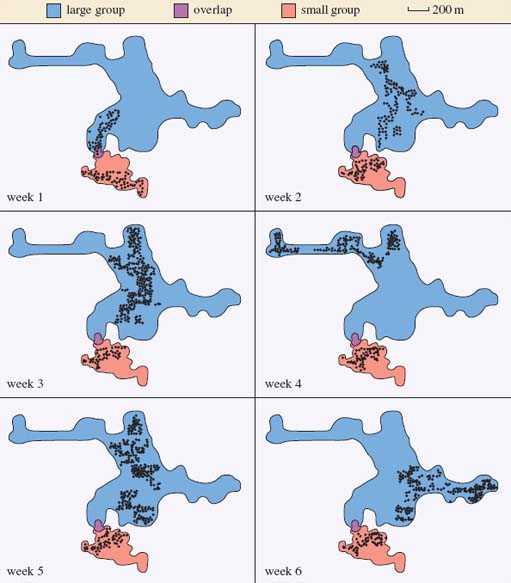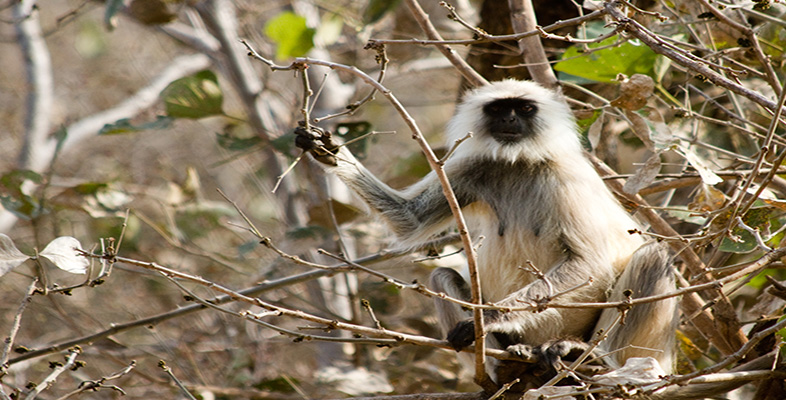4 Living in a society
4.1 Group size and collaboration
This section requires you to interpret the data presented in Figures 5 and 6. Figure 5 consists of two bar charts showing (a) the mean day range and (b) the weekly home range for a large and a small group of red colobus monkeys. They look rather similar, but check the labelling on the vertical axis. The day range is expressed in metres, while the weekly home range is given in hectares (ha). One hectare is an area of 10 000 square metres (m2). The text explains that the mean day range is a distance, whereas the weekly home range is an area. Remember always to check the units in which data are given. Notice too that these two diagrams show alternative ways of representing the same data; what is shown as an area (of feeding trees) on a map in Figure 6 is represented as the height of an individual bar on the bar chart in Figure 5b.
Primates can be found in variable-sized groups, from pairs up to groups of several hundred. Some of the driving forces behind group-living in other species of mammals are finding and defending food resources, and avoiding predation. For example, a pack of grey wolves can bring down a bison that may weigh nearly one tonne (1000 kg), prey that could not be captured by a lone wolf [p. 131]. For individuals that are prey for carnivores such as wolves, vigilance is vital. Herbivores such as zebra and impala herd together, so there is always at least one individual alert to danger and the chances of any one individual being singled out for attack are reduced.
Most researchers believe that overall size of a primate group is determined by food availability. Living in a group may enable members to defend their resources from other groups. However, as they forage together there may be less food available per individual compared to the amount that one individual could find by foraging alone. If food is readily available, the group can be large. For example, geladas feeding on savannah grasses live in very large communities of up to 800 individuals, but if a group has to travel to find food, it is likely that a large group has to travel further than a small group of the same species to satisfy their food requirements. This question was investigated in two groups of leaf-eating, red colobus monkeys living in the wild in Uganda. Researchers carried out what are called focal searches, concentrating on one individual in the group for a set time and then moving to another individual and then another, monitoring each for the same length of time. This procedure allows the movement of the whole group to be determined throughout the day. The researchers calculated the following measures:
the mean day range - the distance travelled by each group on average each day over a one-week period;
the weekly home range - the total area explored by each group in a week, for each of six consecutive weeks;
the total home range explored by each group during the six-week period.


Activity 6
Look carefully at the data shown in Figures 5 and 6 above, including the information in the keys and in the captions. Note that the area of weekly home range is shown graphically in Figure 5b and as an area of feeding trees (dots) on the map of each total home range in Figure 6.
(a) What does Figure 5 tell you about the distance travelled by the two groups?
(b) You might well be bemused by results showing that leaf-eating monkeys are travelling up to 800 m a day. You will have already read that leaves are so nutritionally poor that other leaf eaters, howler monkeys, have little energy and tend not to travel far [p. 255]. Write four or five sentences suggesting why this statement may be true for howler monkeys but not true for red colobus monkeys [p. 266]. (You may wish to refer to LoM Chapter 4.)
Answer
(a) The mean day ranges and the weekly home ranges of the large group (in blue) are much larger than for the small group (in red), showing that the large group travelled considerably further than the small group. (Indeed, the small group never travelled as far in one day as the shortest distance travelled by the large group in a comparable time.)
(b) Both howler and red colobus monkeys have evolved digestive systems capable of supporting a mainly leaf-eating diet, but the adaptations differ between the two species. Howlers, like elephants and horses, are hindgut fermenters, possessing a caecum and an enlarged lower intestine that contains bacteria and protoctists capable of digesting cellulose, the main component of leaves. Red colobus, however, have cellulose-digesting microbes, similar to those found in howlers, in one or more compartments of a specialised stomach, an arrangement comparable to that of pseudo-ruminants. Although there are exceptions, the digestion of cellulose in the more anterior parts of the gut (as in the red colobus) is generally a very efficient process - more so than the comparable process in hindgut fermenters such as howlers. Such a difference may help explain why red colobus are able to expend more energy on travel.
It is worth noting that red colobus are still low energy users compared with other species of monkey; for example, fruit-eating spider monkeys travel much further than 1 km per day and may have a total home range of over 300 ha.
Question 12
Question: What can you infer about the weekly and total home ranges for both groups from Figures 5 and 6?
Answer
Each group forages within its own home range or territory although there is a small area in which both groups forage. The territory of the large group is much larger, in fact seven times larger, than the territory for the small group, which is surprising, given that the large group contained only twice as many individuals. The small group tended to forage in the same part of their territory from week to week, whereas the large group tended to move to a different area each week.
Question 13
Question: The data clearly demonstrate that the large group travels further per day across a larger area than the small group, but do they show that these differences are related to food availability?
Answer
The fact that the large group forages in a different part of its total range each week suggests that the food resources in one part of the forest are becoming depleted and the group has to move into another area to exploit new food resources. To confirm this suggestion, researchers need to investigate the food resources. If food availability is the same for each group, you would expect the large group to travel twice as far as the small group to gain the same amount of food per individual.
Question 14
Question: Suggest some factors that could be measured to compare the food resources available to the two groups.
Answer
You might suggest comparing the total number of feeding trees or the different species of feeding trees in the weekly ranges for each group. Or you might suggest determining the nutritious quality of the leaves (one estimate is the ratio of protein to cellulose, as protein is more nutritious than cellulose).
The other factor determining group size may be the need to avoid predators. In other mammals, such as savannah-living herbivores, as groups become larger, so vigilance can be shared between more individuals, reducing the risk of predation. Primate groups also tend to be larger in areas with high predation than in areas with lower predation, but what happens if the habitat cannot support large groups of particular species even though the risk of predation is high?
Activity 7
(a) From the TV programme, suggest how some monkey species reduce the risk of predation.
(b) Why might you find such behaviour surprising?
(c) Referring to your notes from Activity 5, write a few sentences to explain how monkeys in these associations reduce competition and improve cooperation.
Answer
(a) By forming mixed-species associations, in which different species, such as emperor and saddleback tamarins or sooty mangabeys, guenons, Dianas and colobus monkeys travel and forage together. Vigilance is increased because there are more individuals present than if the species were travelling and foraging separately. (See the sequences from 18.20-20.38 and 26.03-30.35.)
(b) You might suggest that this behaviour is surprising because normally you would expect different species of primate to compete for resources, or because such cooperation requires all species in the association to be able to respond to each other's alarm calls.
(c) Competition for food is usually avoided because each species occupies different levels within the canopy. In the Tai Forest, sooty mangabeys are on the ground, Diana monkeys are at the top of the canopy and several other species occupy the middle layers. Individuals in these associations are able to recognise and respond to alarm calls generated by any of the other species as well as their own.
In fact, these associations have given some fascinating insights into vocal communication in monkeys. As explained in LoM, 'the cat sat on the mat' is not the same as 'the mat sat on the cat' [p. 271], but until now, there has been no evidence of monkeys in the wild comprehending such syntactic rules.
Recent research, however, suggests that Diana monkeys foraging with Campbell's monkeys may be able to recognise the order of a series of calls. It was found that:
When Dianas hear a leopard or an eagle alarm call from a Campbell's, they give the corresponding alarm call of their own.
Male Campbell's monkeys also make a third type of call, a low-pitched boom.
If a Campbell's perceives a lesser threat, such as a falling tree, he utters two boom calls followed by a leopard call - a series of calls referred to as a boom-introduced alarm call.
When Dianas hear a boom-introduced alarm call they do not give leopard calls of their own.
Similarly, when booms were added experimentally to the eagle calls of a Campbell's and played back to Dianas, the Dianas made no eagle calls.
These responses suggest that boom calls alter the Diana monkeys' interpretation of subsequent Campbell's alarm calls, changing them from predator-specific calls to calls indicating a lesser threat. This conclusion is further supported by the observation that Dianas do respond to a played-back Diana call that is preceded by the boom calls of a Campbell's. This evidence is the first to suggest that the cognitive ability to generate and comprehend syntactic rules, albeit a very simple rule, evolved long before the emergence of human language.
Although these two factors (food availability and the avoidance of predators) influence the upper limit on group size in a particular environment, it is the rich diversity of internal relationships within anthropoid groups that is fascinating and has led to many studies of primates.
